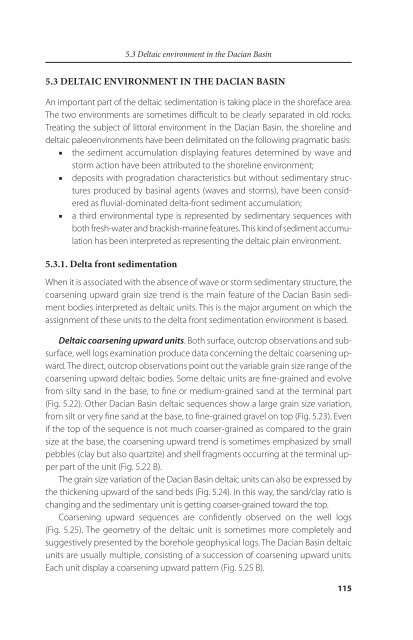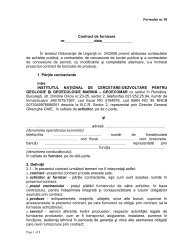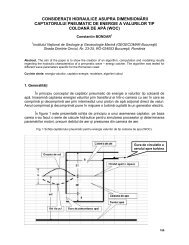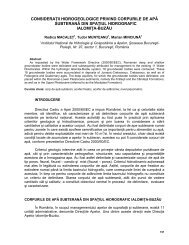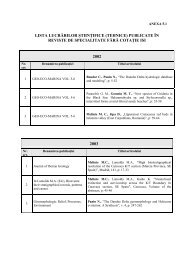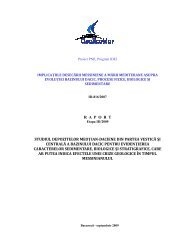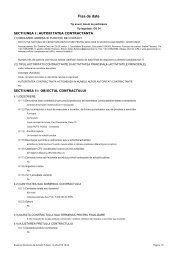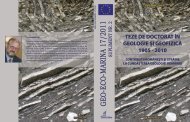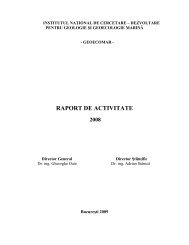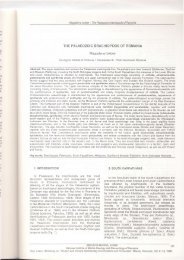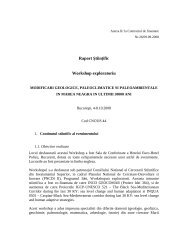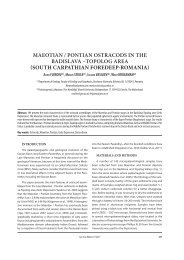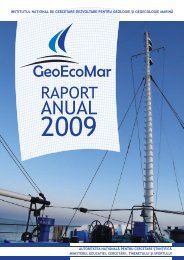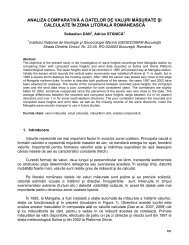DACIAN BASIN - GeoEcoMar
DACIAN BASIN - GeoEcoMar
DACIAN BASIN - GeoEcoMar
You also want an ePaper? Increase the reach of your titles
YUMPU automatically turns print PDFs into web optimized ePapers that Google loves.
5.3 Deltaic environment in the Dacian Basin<br />
5.3 DELTAIC ENvIRONMENT IN THE <strong>DACIAN</strong> <strong>BASIN</strong><br />
An important part of the deltaic sedimentation is taking place in the shoreface area.<br />
The two environments are sometimes difficult to be clearly separated in old rocks.<br />
Treating the subject of littoral environment in the Dacian Basin, the shoreline and<br />
deltaic paleoenvironments have been delimitated on the following pragmatic basis:<br />
■ the sediment accumulation displaying features determined by wave and<br />
storm action have been attributed to the shoreline environment;<br />
■ deposits with progradation characteristics but without sedimentary structures<br />
produced by basinal agents (waves and storms), have been considered<br />
as fluvial-dominated delta-front sediment accumulation;<br />
■ a third environmental type is represented by sedimentary sequences with<br />
both fresh-water and brackish-marine features. This kind of sediment accumulation<br />
has been interpreted as representing the deltaic plain environment.<br />
5.3.1. Delta front sedimentation<br />
When it is associated with the absence of wave or storm sedimentary structure, the<br />
coarsening upward grain size trend is the main feature of the Dacian Basin sediment<br />
bodies interpreted as deltaic units. This is the major argument on which the<br />
assignment of these units to the delta front sedimentation environment is based.<br />
Deltaic coarsening upward units. Both surface, outcrop observations and subsurface,<br />
well logs examination produce data concerning the deltaic coarsening upward.<br />
The direct, outcrop observations point out the variable grain size range of the<br />
coarsening upward deltaic bodies. Some deltaic units are fine-grained and evolve<br />
from silty sand in the base, to fine or medium-grained sand at the terminal part<br />
(Fig. 5.22). Other Dacian Basin deltaic sequences show a large grain size variation,<br />
from silt or very fine sand at the base, to fine-grained gravel on top (Fig. 5.23). Even<br />
if the top of the sequence is not much coarser-grained as compared to the grain<br />
size at the base, the coarsening upward trend is sometimes emphasized by small<br />
pebbles (clay but also quartzite) and shell fragments occurring at the terminal upper<br />
part of the unit (Fig. 5.22 B).<br />
The grain size variation of the Dacian Basin deltaic units can also be expressed by<br />
the thickening upward of the sand beds (Fig. 5.24). In this way, the sand/clay ratio is<br />
changing and the sedimentary unit is getting coarser-grained toward the top.<br />
Coarsening upward sequences are confidently observed on the well logs<br />
(Fig. 5.25). The geometry of the deltaic unit is sometimes more completely and<br />
suggestively presented by the borehole geophysical logs. The Dacian Basin deltaic<br />
units are usually multiple, consisting of a succession of coarsening upward units.<br />
Each unit display a coarsening upward pattern (Fig. 5.25 B).<br />
115


